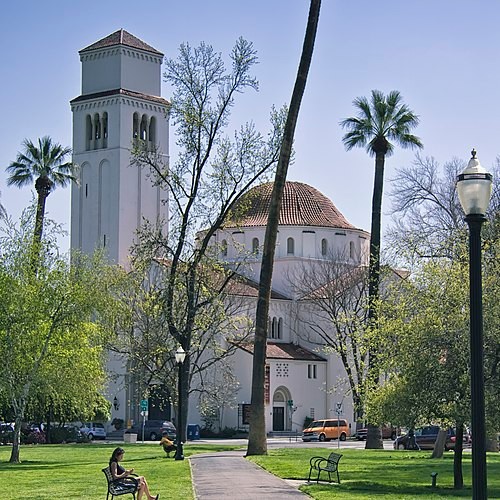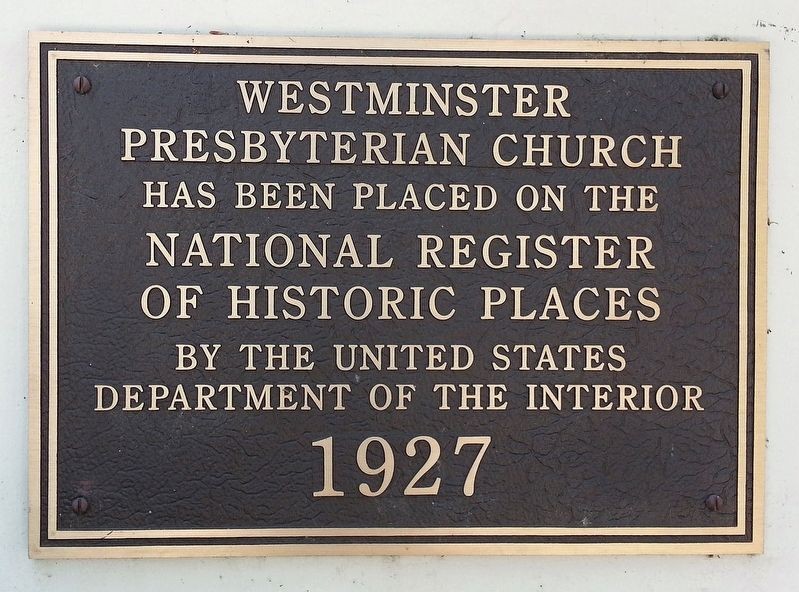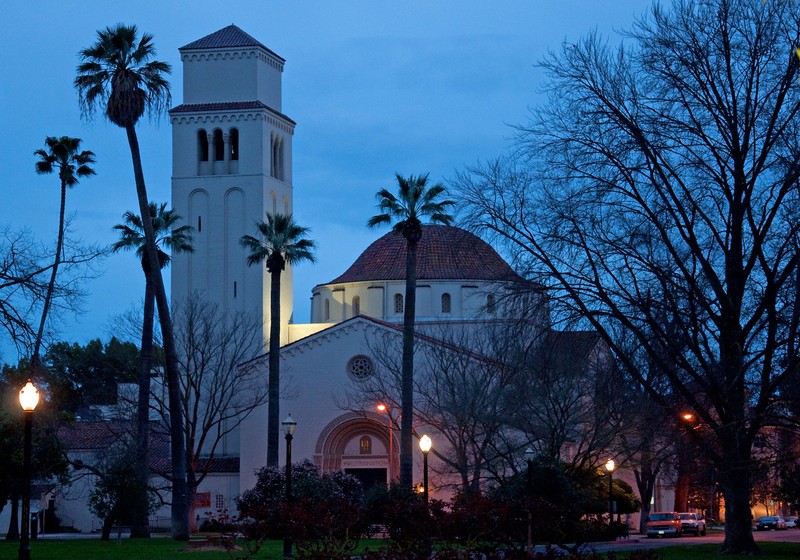Westminster Presbyterian Church
Introduction
Text-to-speech Audio
Built in 1927, Westminster Presbyterian Church was designed in the Spanish Eclectic style by the Sacramento architectural firm of Dean and Dean. Occupying two full city lots, the smaller Queen Anne residences in the neighborhood were demolished to make way for the construction of the new church. Influenced by Romanesque and Gothic architecture, the overall design was inspired by the Hagia Sophia in Istanbul, with a tiered bell tower resembling St. Mark’s Campanile in Venice. Westminster Presbyterian Church was added to the National Register of Historic Places in 2003.
Images
Westminster Presbyterian Church

Westminster Presbyterian Church historical marker

Westminster Presbyterian Church

Backstory and Context
Text-to-speech Audio
Initially organized in 1856, the Westminster Presbyterian Church incorporated the California Mission style with traditional European architecture. Designed by the architect Charles Dean, the expansive church was constructed in the 1920s in the Spanish Eclectic style. Since the late 19th century, Queen Anne and Italianate architecture had remained predominant in Sacramento. After World War I, however, this emphasis shifted in favor of the more traditional European styles, including English Tudor Revival, Italian Renaissance Revival, Norman, and Spanish Eclectic.
The church’s bell tower rises to 116 feet tall and is visible at a distance from Sacramento’s Capitol Park. Equipment was installed in 1942 to broadcast chimes from the tower. The Spanish Eclectic style is reflected in the church’s low-hipped roofs, mission tiles, and stucco surfacing. A wrought iron gate stands at the entrance to the passageway that connects the front gable with the chapel. In 2001, a decorative fountain was added adjacent to the western wall. The church’s semi-circular dome, which was based on the Byzantine dome of the Hagia Sophia in Istanbul, Turkey, sits on a drum that rests upon a square base.
The church's interior was designed in the shape of a Greek cross, with a dome that stretches sixty feet in diameter, rising eighty-seven feet over the center of the nave. Two rose windows with stained glass panels were planned at the time of construction, but the project was not completed due to a lack of funding. The windows were installed with clear glass until the one-hundredth anniversary of the Westminster Presbyterian Church in 1956, when they were replaced by stained glass manufactured by Henry Willet Stained Glass Studios of Philadelphia. The Reuter Organ Company manufactured the original organ, and a Moller pipe organ was installed in 1983.
Sources
"A 'one of a kind building Styles: Byzantine, Italian Romanesque, Lombardic, Spanish", Westminster Presbyterian Church. Accessed September 18th, 2023. https://www.westminsac.org/post/one-kind-building.
"About the architect", Westminster Presbyterian Church. Accessed September 18th, 2023. https://www.westminsac.org/post/about-architect.
"California SP Westminster Presbyterian Church: Nomination Form, National Register of Historic Places", National Archives. April 7th, 2003. Accessed September 18th, 2023. https://catalog.archives.gov/id/123860694.
"National Register #03000425: Westminster Presbyterian Church", Noe Hill. Accessed September 18th, 2023. https://noehill.com/sacramento/nat2003000425.asp.
"Our Historic Building", Westminster Presbyterian Church. Accessed September 18th, 2023. https://www.westminsac.org/westminsters-history.
"Spanish Revival (1915-1940)", Noe Hill. Accessed September 18th, 2023. https://noehill.com/architects/style_spanish_colonial_revival.aspx.
Photo by Steven Pavlov, CC BY-SA 3.0, https://en.wikipedia.org/wiki/Westminster_Presbyterian_Church_%28Sacramento,_California%29#/media/File:Sacramento,_CA_%E2%80%94_Westminster_Presbyterian_Church_(cropped).jpg
Douglass Halvorsen, Historical Marker Database
Photo by Steve Rouhotas, CC BY-SA 3.0, https://en.m.wikipedia.org/wiki/File:Westminster_Presbyterian_Church_sacramento_Ca.jpg
